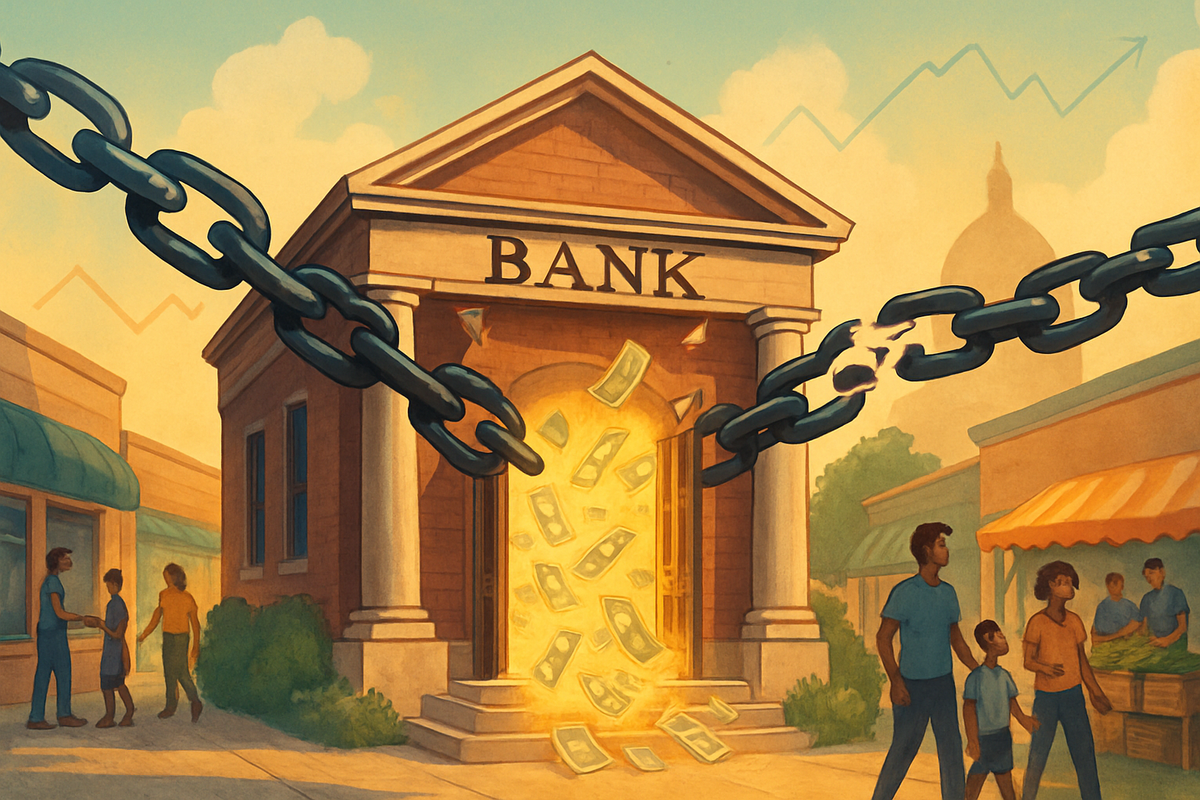
A significant shift in U.S. financial regulation is on the horizon, as a recent Bloomberg News report, published on October 15, 2025, indicates that federal regulators are prepared to offer substantial capital relief to community banks. This pivotal move aims to invigorate local economies by encouraging smaller institutions to ramp up lending, potentially injecting much-needed liquidity into small businesses and households across the nation. The immediate implications suggest a more dynamic credit market, but also raise questions about its broader economic effects and the Federal Reserve's delicate balancing act with monetary policy.
The core of this anticipated regulatory adjustment involves a proposed relaxation of the Community Bank Leverage Ratio (CBLR), a key metric that dictates the capital cushion banks must hold. By easing these requirements, regulators hope to free up capital that community banks can then deploy into loans, fostering economic growth at a grassroots level. This initiative is a clear signal of a tailored regulatory approach, acknowledging the distinct role and operational models of community banks compared to their larger counterparts, and setting the stage for a potentially transformative period for the sector.
The Regulatory Reset: Details and Drivers Behind the Capital Concession
The forthcoming capital relief centers on a crucial modification to the Community Bank Leverage Ratio (CBLR). Regulators are reportedly poised to propose lowering the CBLR threshold from its current 9% to 8%, the lowest level permitted by law. This adjustment would allow eligible community banks (those with less than $10 billion in total consolidated assets) to comply with a simpler, less burdensome capital standard, sidestepping the more intricate risk-based capital calculations tied to their loan portfolios. This simplified approach is designed to make the CBLR framework more attractive, as Federal Reserve Vice Chair for Supervision, Michelle Bowman, noted in early 2025 that the current 9% threshold had not achieved its intended relief, with only a fraction of eligible banks opting in.
The Bloomberg News report, released on October 15, 2025, highlights that this proposal has already undergone review by the White House, signaling a broad consensus among policymakers. It is expected to be formally put forth by the trio of U.S. financial regulators: the Federal Reserve, the Federal Deposit Insurance Corporation (FDIC), and the Office of the Comptroller of the Currency (OCC). Following its official release, the proposal will be subject to a public comment period, allowing industry stakeholders and the public to provide feedback before its final adoption.
The primary objective driving this regulatory shift is to incentivize community banks to significantly increase their lending activities. By reducing the capital they are mandated to hold, regulators aim to unlock "extra resources" that these institutions can channel into meeting the financial demands of their customers. This is particularly vital given that lending remains the core profit driver for most community banks, with small business, commercial real estate (CRE), and commercial and industrial (C&I) lending identified as critical areas for growth and profitability in the current financial year. The immediate market sentiment leans towards optimism, with expectations of increased loan growth from community banks, a reduction in their regulatory burden, and a general positive reception for a "bank-friendly" regulatory environment.
While the specific, immediate stock market reaction to the October 15 Bloomberg report is still unfolding, the overarching sentiment within the financial sector is one of cautious approval. Such regulatory easing is generally viewed as supportive of the banking industry. This move also underscores a clear differentiation from the ongoing discussions around capital rules for larger financial institutions, where the focus is often on increasing capital buffers. For community banks, however, the goal is unequivocally to foster local lending and stimulate economic expansion by reducing administrative hurdles and enhancing operational flexibility.
Corporate Crossroads: Who Wins and Loses in the New Regulatory Climate
The proposed capital relief is poised to create distinct winners and losers within the financial services sector, with publicly traded community banks emerging as the primary beneficiaries. Institutions like First Financial Bankshares (NASDAQ: FFIN), BancorpSouth Bank (NYSE: BXS), or Old National Bancorp (NASDAQ: ONB), which typically fall within the asset thresholds for regulatory tailoring (generally under $10 billion for CBLR eligibility or under $3 billion for extended examination cycles), stand to gain significantly. For these banks, the relaxation of the CBLR from 9% to 8% directly translates into reduced compliance costs and increased capital flexibility. This allows them to reallocate resources away from extensive regulatory overhead and towards their core function of relationship-based lending, directly boosting their net interest margins and overall profitability through increased loan growth in areas like small business and commercial real estate.
The operational efficiencies gained from simplified capital calculations and streamlined examination procedures, as also introduced by the OCC for community banks with up to $30 billion in assets, will further enhance their bottom lines. This means less administrative burden and more capacity to serve their local communities, potentially allowing them to offer more competitive rates or terms in their specific markets. While not entirely eliminating the competitive pressures from larger institutions, this relief provides a much-needed boost, enabling these smaller banks to better leverage their deep local knowledge and personalized service models.
However, the competitive landscape is not without its complexities. Larger banks, particularly Global Systemically Important Banks (G-SIBs) and those with over $100 billion in assets, face a different regulatory trajectory under the Basel III Endgame proposals, which generally aim to increase capital requirements. While an anticipated reproposal is expected to focus stricter capital increases on the largest, most internationally active U.S. banks, these institutions are also engaged in separate discussions around potentially easing their Supplementary Leverage Ratio (SLR). If successful, such relief could free up billions in capital for financial giants like JPMorgan Chase & Co. (NYSE: JPM) or Bank of America Corp. (NYSE: BAC), allowing them to further invest in technology, reduce loan rates, and expand their market dominance, potentially intensifying competition for community banks.
Moreover, community banks continue to grapple with the inherent challenges of scale, particularly in technology investment. The widening technology gap with larger institutions, coupled with ongoing consolidation pressures within the community banking sector, means that even with regulatory relief, smaller players must strategically adapt. While the capital relief offers a significant advantage, the long-term viability for many community banks will depend on their ability to leverage these efficiencies against the broader market forces and the aggressive competitive strategies of their larger, more technologically advanced rivals. This dynamic could lead to continued M&A activity, where some community banks may find strategic mergers necessary to gain scale and access to advanced capabilities.
Broader Economic Canvas: Inflation, Growth, and the Fed's Tightrope Walk
This regulatory pivot for community banks is not an isolated event but rather a significant component of a broader industry trend towards 'tailored' regulation, a philosophy gaining considerable traction, particularly under the current administration. The move acknowledges that a one-size-fits-all approach to financial oversight can disproportionately burden smaller institutions, stifling their ability to serve local economies. By reducing compliance costs and freeing up capital, regulators are actively seeking to empower community banks to become more robust engines of local economic growth, filling critical lending gaps that larger, more impersonal institutions might overlook.
The ripple effects of this capital relief are expected to be felt most acutely by small businesses and households, who stand to benefit from increased access to credit. Community banks are often the lifeblood of local commerce, and greater lending capacity from these institutions could fuel capital expenditures, job creation, and overall economic expansion at the grassroots level. However, this positive impact must be viewed within the context of a bifurcated regulatory landscape. While community banks receive relief, larger banks are simultaneously navigating their own capital adjustments, with changes to the enhanced Supplementary Leverage Ratio (eSLR) for Global Systemically Important Banks (GSIBs) potentially freeing up billions in capital. This could intensify competition, with megabanks potentially lowering loan rates and accelerating technology investments, creating a challenging environment for smaller players.
From a policy perspective, the proposed reduction of the CBLR to 8% is a direct regulatory response to industry feedback, aiming to make the simplified capital framework genuinely effective. This is complemented by the OCC's proactive measures, announced in October 2025, to streamline examination procedures, offer flexibility in model risk management, and reduce bureaucratic hurdles. These actions collectively underscore a concerted effort to foster a "community bank comeback," as articulated by Treasury Secretary Scott Bessent. Historically, such tailoring echoes the intent behind the Economic Growth, Regulatory Relief, and Consumer Protection Act of 2018 (EGRRCPA), which first introduced the CBLR and other forms of relief, marking a departure from the post-2008 era of heightened regulatory stringency.
The indirect effects on the broader economy, inflation, and the Federal Reserve's monetary policy considerations are substantial. Increased lending from community banks, if successfully stimulated, could provide a welcome boost to overall economic growth, complementing the Fed's recent pivot towards interest rate cuts, which began in late 2024 and continued into September 2025. However, this also presents a delicate balancing act for the Fed. If the surge in lending leads to an overly aggressive increase in demand, it could risk reigniting inflationary pressures, which, despite moderating, remained slightly above the Fed's 2% target in September 2025. The Fed will need to carefully monitor these dynamics, ensuring that regulatory flexibility promotes growth without undermining price stability. For community banks, while lower interest rates might stimulate borrowing, they could also compress net interest margins (NIMs), necessitating careful balance sheet management in this evolving economic climate.
The Road Ahead: Opportunities, Challenges, and Strategic Imperatives
In the short term, over the remainder of 2025 and into 2026, community banks can anticipate an immediate uplift from this capital relief. The most direct outcome will be increased lending capacity, allowing them to expand credit offerings to small businesses and households, particularly in local and often underserved markets. This, combined with a significantly reduced regulatory burden due to streamlined capital calculations and examination procedures, is expected to contribute to a stronger earnings outlook. As the Federal Reserve continues its dovish pivot with anticipated interest rate cuts, community banks could see improved net interest margins, further bolstering their profitability. This newfound flexibility will also enable more strategic deployment of capital, whether for technology investments, modest acquisitions, or enhanced shareholder returns.
Looking further ahead, the long-term possibilities for community banks are centered on reinforcing their unique value proposition. With reduced compliance distractions, they can double down on their core mission of relationship-based banking, fostering deeper ties within their communities. This could lead to modernized operations through strategic technology adoption and partnerships, allowing them to compete more effectively with larger institutions. Furthermore, the relief might enable community banks to achieve greater dominance in specific niche markets, such as agricultural lending or particular small business segments, where their local expertise provides a distinct advantage.
However, to fully capitalize on these opportunities, strategic pivots will be essential. Community banks must embrace advanced technologies, including artificial intelligence for fraud detection and back-office efficiencies, often through alliances to share costs. Data-driven decision-making will be crucial for optimizing lending portfolios and managing risk. Proactive capital planning and robust risk management, particularly concerning interest rate sensitivity and commercial real estate (CRE) exposure, remain paramount. The ongoing trend of consolidation will also necessitate strategic mergers and acquisitions to achieve economies of scale and access new capabilities. The challenge, however, will be navigating intensified competition from larger banks and agile fintechs, managing technology costs, and adapting to other evolving regulatory requirements like Dodd-Frank Sections 1071 and 1033. The sector is likely to see a mixed outcome: some community banks thriving through adaptation, while others face increasing pressure and potential acquisition.
MarketMinute's Final Take: A Balancing Act for the Future of Community Banking
The current wave of capital relief and regulatory tailoring for U.S. community banks represents a significant and timely policy shift. Key takeaways include the OCC's proactive deregulation efforts, the anticipated adjustment of the Community Bank Leverage Ratio (CBLR) to 8%, and the explicit exemption of community banks from the more onerous aspects of the Basel III Endgame proposals. These measures, championed by the current administration, signal a clear commitment to fostering a "community bank comeback" by reducing compliance burdens and encouraging local lending. However, the maturation of CECL implementation means that robust credit risk management remains a permanent and critical expectation.
Moving forward, the market outlook for community banks in late 2025 and into 2026 is generally positive. Analysts project improved earnings and expanding net interest margins, supported by anticipated Federal Reserve interest rate cuts. While asset quality is expected to remain stable, an acceleration in mergers and acquisitions (M&A) activity is likely, driven by the need for scale and improved market conditions. Yet, competitive headwinds persist, primarily from larger banks that may also benefit from their own capital adjustments, potentially leading to a "race to the bottom" on loan rates and further widening the technology gap. The economic backdrop of a projected "soft landing" in 2025 and continued Fed easing provides a generally supportive, though carefully monitored, environment.
The lasting significance of this regulatory easing will be determined by its ability to genuinely preserve and strengthen the vital role of community banks in the U.S. financial system. It underscores the recognition that proportionate regulation is essential for a diverse and resilient banking sector. If successfully implemented and leveraged, this could lead to a more efficient and adaptive community banking industry. However, investors must remain vigilant. The ultimate impact will depend on how effectively community banks can translate regulatory relief into competitive advantages against their larger rivals, and how the broader regulatory landscape, particularly concerning large banks, evolves.
Investors should closely watch several key indicators in the coming months. The finalization and widespread adoption of the 8% CBLR will be a critical development, as will the practical implementation and impact of the OCC's new risk-based examination framework. Decisions regarding Basel III Endgame and any adjustments to the Supplementary Leverage Ratio (SLR) for large banks will shape the competitive dynamics. Furthermore, monitoring the Federal Reserve's interest rate policy, evolving credit quality trends, and the pace of M&A activity will provide crucial insights. Finally, attention should be paid to regulatory enforcement of CECL and any further deregulatory initiatives from the administration, as these will continue to shape the operating environment for community banks.
This content is intended for informational purposes only and is not financial advice






